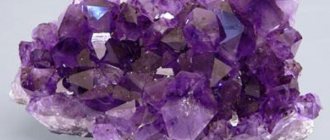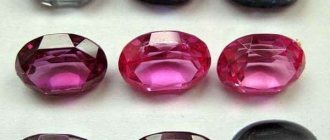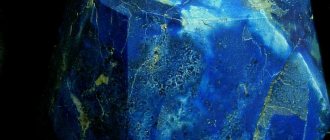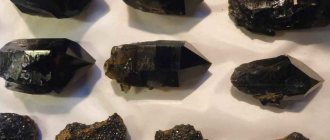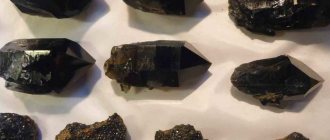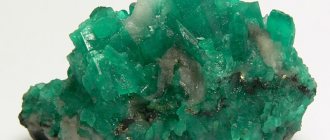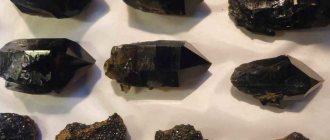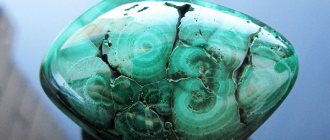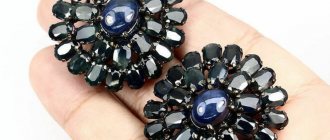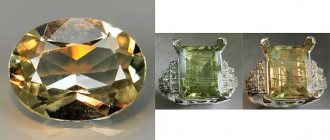Checking a gemstone for authenticity, as a rule, involves checking the jewelry stone (insert) for compliance with the information stated during the sale and purchase.
When checking the authenticity of a stone, it is necessary to confirm the declared mineral type and variety, the nature of origin, the presence or absence of refining, and also to determine the quality characteristics of the declared ones.
How to distinguish a real stone from a fake
Often, determining the material and origin of a jewelry insert is difficult due to setting, and then it is necessary to use a set of available determination methods, both direct - determining the diagnostic constants of minerals, and indirect - allowing one to judge the mineral type indirectly.
Diagnosis of a mineral species in the simplest case is carried out on the basis of measured optical-structural constants of minerals, but subject to limited access (including for visual inspection), additional methods are used, such as:
- thermal conductivity research;
- electrical conductivity study;
- study of magnetic properties;
- study of the nature of various types of luminescence.
In minerals partially accessible to visual observation, the following methods are used:
- study of the appearance of internal microinclusions;
- examination of the surface (its defects and individual characteristics);
- study of the nature of pleochroism;
- study of the nature of birefringence;
- investigation of internal structural anomalies.
When determining organic jewelry stones and diamond, in addition to measuring optical constants, Raman and luminescence spectroscopy, the infrared spectroscopy method is used to identify characteristic carbon-containing compounds.
A little about stones and fakes
A real stone is always a profitable purchase: products inlaid with gems do not lose in price, and over the years the cost of such jewelry only increases. But the concept of “real stone” includes only those minerals that were found in the bowels of the earth.
Even if the crystal has been processed and gone through a refining procedure, its price will be lower. Treated stones are no different from their counterparts in terms of characteristics; they are processed for several reasons, the main one of which is considered to be insufficiently bright color. The procedure helps to give nondescript gems a unique shade that is rarely found in nature.
The properties of crystals processed in this way will not change and, despite the refining, the gemstone will not become worse. But minerals processed in this way are cheaper, since their amazing shade was given not by nature, but by the hand of man. It is difficult to call such pebbles a fake, since they are still of natural origin.
It is actually not difficult to distinguish natural stone from artificial stone. To understand the authenticity of a gem, just ask a jewelry retailer for a certificate.
A certificate is a document that is issued for each mineral; it contains information about the stone itself, its characteristics: size, color, purity, presence of defects, cutting method and even place of extraction. If the seller of jewelry refuses to provide a certificate to the buyer, this means that the jewelry does not have any documents. And it is impossible to confirm the authenticity of the minerals with which the products are inlaid.
It is worth noting that all stones, precious and semi-precious, pass through the hands of an appraiser. Craftsmen determine the cost of gems by assessing their characteristics. After evaluating the stones, there is a direct path to the jewelers who manufacture the products. They select the frame and create this or that item.
It is for this reason that an appraiser can determine the authenticity of a mineral; if you put the gem in the hands of a master, he will determine its real value. Such an examination costs money; the appraiser’s work must be paid.
There are several more ways to help recognize a fake.
For identification you need:
- Minimum information about the stone being purchased.
- The ability to examine a mineral through a magnifying glass.
- Simple examination at home.
- Frame identification.
Minimal information about the gem you plan to purchase will help you recognize an imitation or fake. It is worth collecting information about what shades the mineral has, in what places it is mined and how it is cut. All this will be enough to avoid purchasing glass instead of a precious stone. To distinguish a crude fake from a gem of natural origin, this information is quite enough.
Rough natural diamonds
A microscope, magnifying glass, or any other instrument can be used in authentication. A mineral created in a laboratory is pure; there are no inclusions in its structure, which jewelers call defects. But the stone that was found in the bowels of the earth probably has defects, some of which can be seen using a magnifying glass. The presence of such defects is a sign that the crystal was created by nature and not by human hands.
A simple check will help determine the authenticity of the crystal. If we are talking about a diamond, it is enough to simply slide it across the mirror. The stone will scratch the glass, but such a check will not harm it at all. The density of precious stones is high, for this reason they are difficult to scare with alkalis and acids; even hitting a diamond with a hammer will not harm it. But the fake crumbles to pieces.
The frame is another element that can give away a fake. Precious and semi-precious stones are not set in base metal settings. Gold and platinum are the main metals used as settings for gems. Silver products can also be found on the market, but rare and expensive crystals are not framed with silver, since the metal is not of high value.
Certain gems are produced in laboratories and synthesized on an industrial scale. Such stones are often used to make electrical appliances and even car windows. A certain amount of crystals synthesized in laboratories ends up in the hands of jewelers. Such pebbles differ from those found in the bowels of the earth, but the comparison is not always in favor of minerals that are of natural origin.
In terms of their characteristics and appearance, gems synthesized in the laboratory can be on par with their natural counterparts. But what man does is not always as beautiful as what nature creates.
Naturally, crystals made in a laboratory are not very expensive; they cannot be called rare or valuable. Humanity does not experience a shortage of such minerals, so jewelry inlaid with such stones does not increase significantly in price. There is no point in investing money in such products.
An experienced appraiser can easily distinguish a gem made in a laboratory from one that is of natural origin. But it will be difficult to deal with those minerals that have gone through the refining procedure. Sometimes it is impossible to determine that a stone has been processed, since it has all the necessary characteristics and can “fool” even an experienced specialist.
Features of checking a gemstone for authenticity
Determining the quality characteristics is best done for a stone that is in loose form, since when assessing the parameters of a stone installed in a piece of jewelry, a significant error may occur. This error is minimal and does not exceed 5% in weight and 1 group of color and clarity for a stone with high quality cutting characteristics, set in the most open setting. But if the quality of the stone cut deteriorates, and it is set in a frame that impairs viewing and the ability to take measurements, and has mirrored, matte or colored surfaces, the error may increase.
semiprecious stones. their photos and how to check their naturalness
I really love this pebble, which is why I intervened in the process. VARISCITE The mineral got its name from the town of Variscite in Saxony. Other names for the mineral and its varieties: Californian turquoise, chlorutealite, lutznite, spherite, boltvariite, amatrix.
Variscite is a hydrous aluminum phosphate mineral that occurs as pseudooctahedral crystals and fine-grained kidney-shaped aggregates. The A.E. Fersman Mineralogical Museum of the Russian Academy of Sciences houses a polished section of a stone brought from the United States of America. Its color resembles the green-azure surface of warm tropical waters. The “discovery” of variscite took place in 1837. The translucent mineral variscite owes its shades of color, which varies from apple green to yellow and blue, to impurities of iron and chlorine compounds.
Hardness - 4.0-5.0; density - 1.3-2.6 g/cm3.
Main deposits: Australia, Germany, Brazil.
Features of education. Formed in oxidation zones.
Chemical composition: AlPO4 2H2O
Medicinal properties Since variscite was discovered relatively recently and is quite rare, its medicinal properties have not been well studied. Lithotherapists recommend wearing it for people prone to unreasonable fears, suffering from insomnia and nightmares.
Magical properties Variscite is a stone for people seeking spiritual development. If you meditate with it, it will help to reveal the most unexpected abilities and capabilities of its owner. A person can even remember all his past lives, and the mineral will tell him what misdeeds he committed in past incarnations are causing him any troubles in this life.
Variscite makes its owner merciful, sensitive to the suffering and hardships of other people, forces its owner to help everyone who needs help (even if he is not asked for it). Thus, the mineral helps a person correct all voluntary and involuntary offenses that he has committed in past and present lives. He persistently inspires the owner: “Hurry to do good!”
By arousing the best qualities in a person, variscite thus helps him attract love, luck and prosperity, although the owner of variscite will never become a multimillionaire, a famous person or a famous heartthrob - the mineral will not allow this to happen, since it believes that these benefits will burden karma his owner. He will attract exactly the amount of luck that will not disfigure the moral foundation of a person. But the stone will teach its owner to enjoy every little thing, to be satisfied with what he has.
Astrologers believe that variscite is simply necessary for people born under the sign of Fire (Aries, Leo, Sagittarius), since by nature they are prone to selfishness and indifference. The rest of the zodiac signs can also wear this stone, with the only exception being Pisces - the stone can harm them, making these initially compassionate people caring to the point of importunity.
Talismans and amulets As a talisman, variscite should be used by medical workers, teachers, educators, clergy, lawyers, representatives of the executive branch and all those whose activities are connected with the destinies of people.
In jewelry, variscite was used as an ornamental stone as a substitute for turquoise in the form of cabochons. In 1894, samples of green variscite intergrown with quartz were discovered in Utah (USA).
Currently, American variscite deposits are completely depleted. The current source of variscite is the territory of Australia. Variscites have also been discovered in Germany and Brazil. Variscite is usually used to make various pendants and pendants. They are made from pieces of variscite and beads, but you rarely see a ring with variscite.
Where to check the authenticity of gemstones
Nowadays, every year new technologies are developed and existing technologies for the synthesis and refining of jewelry stones are improved, as a result of which a standard set of gemological equipment for determining a jewelry insert, the nature of its origin and the availability of possible refining methods is not enough.
Therefore, the most reliable way to make sure that your jewelry stones comply with the data declared by the seller is to contact a specialized gemological laboratory, where specialists using professional equipment will diagnose the properties of your stone and answer all your questions.
Author of the publication: I. Yantarny
Comparison of natural and synthetic minerals
When purchasing a gemstone, you want to be sure that it is natural. However, many are willing to buy and wear synthetic analogues, for example, synthetic rubies or diamonds, and there is nothing wrong with that. Everyone has their own taste and preferences. The main thing is that they don’t sell you synthetic under the guise of natural, because this is fraud and deception of the buyer.
Self-respecting jewelry houses and brands do not mislead consumers and will not pass off one stone as another. Small manufacturers or sellers may resort to deception when asked: what kind of gem is inserted into the product? and who, and begin to vaguely talk about the long journey from Iran through Australia, during which information about the manufacturer was irretrievably lost. The tag of such sellers modestly indicates the type of product (earrings, for example) and the price. It may also be written by hand - “ruby”, but, as can be understood from the above, you can write anything you want, and usually the stone with which the appearance is most similar.
Deception when selling synthetic stone can only consist of an inflated price. If a product with artificially grown chrysoberyl is sold for $10, then there is no fraud in it. It’s another matter if for the same product they ask for 10 times more, 100 dollars, for example, thus passing it off as a natural gem.
Jewelry stores, as a rule, do not indicate which stone is natural or synthetic, especially if the products belong to the so-called “budget” niche. But the seller, of course, will easily confirm the origin of the stones from the laboratory and even competently make it clear why synthetic stones are better than natural ones.
But a synthetically created diamond – moissanite – is even more expensive than its natural “relative”.
So, here’s how the prices for natural and synthetic stones compare:
Cat's eye, synthetic
SYNTHETIC CAT'S EYE. Everything that is sold en masse in stores is imitation and fake in glass (imitation can be easily obtained from cheap fibrous borosilicate glass). Imitation glass can have any sizes and colors and very bright reflections. Glass cat's eye is the most common and inexpensive fake and imitation. Synthetic cat's eye can be of any color: whitish, green or blue, red, pink, yellow, brown, etc. It is very bright and has a strongly pronounced phenomenon of iridescence (a bright noticeable glare running along the surface when rotated). Do not confuse cat's eyes with asterix stones, on the surface of which a star runs along the surface when rotating, rather than a wide stripe. The quality of making a cat's eye made of glass can also be very different - from simple and inexpensive beads to massive, high-quality, well-colored beads and inserts into jewelry with a pronounced glare. It is quite difficult for a non-specialist to distinguish synthetic ulexite from high-quality borosilicate jewelry glass. You need to know what exactly jewelry is made from glass: beads, bracelets, necklaces. In jewelry factories, glass is not set into gold and silver, but a much softer synthetic ulexite is used.
I would like to pay special attention to the photo on the right. Today, synthetic imitations of bright green or yellowish color made from composite material have appeared on the market, passing off as natural chrysoberyl. Its production was allegedly established in China on the basis of special fiber optic glass with coloring additives. The technology was developed in the USA. It is made from rare earth silicates, compressed into a mass of narrow parallel fibers with a diameter of 6 to 10 microns. They are fused to a colored matrix with lower refractive indices. The material is called catsite (“cat’s eye patch”). Small samples can be translucent, large ones are opaque. One cubic centimeter of material contains fibers whose total length exceeds 8 kilometers!! It is a by-product of the development and development of modern fiber optic technologies. Under the guise of natural chrysoberyl, jewelry from ketsite is sold even in specialized departments and stores, at exhibitions and “from hand” or trays at a price of about $50-150 and more for a supposed piece of jewelry. This is a fake and fraud (you can report it to the police). If at the market you buy such beautiful bright green or yellowish beads with micro-tubules and specific iridescence for 5-20 dollars. (no matter what they are called), you can’t go wrong - this is the real and real price of an extremely interesting man-made material. By the way, this material is noticeably more expensive abroad than in Ukraine, but still not comparable in price to chrysoberyl. Theoretically, the following colors are possible: green, honey yellow and blue. Consider that, unlike a cat's eye, a natural chrysoberyl cat's eye costs the same as a similarly sized diamond, or even more.
Another stone with a cat's eye effect is ulexite (boronatrocalcite, a mineral of the hydrous borate subclass, NaCa(B5O9)x8H2O, often synthetic and very widely used in products). For their characteristic shine, color and shimmering elongated strip of light, polished ulexites are often called cat's eyes. The name ulexite comes from the name of the German chemist G. L. Ulex. Quite a soft mineral. It is found as a supergene mineral in lake sediments, a replacement product in clayey gypsum-bearing rocks of salt domes. Boron ore. In nature, ulexite most often forms fine-fibrous solid masses. Ulexite crystallizes in a monoclinic system and forms fine-fibrous solid masses or white radiant aggregates. Due to the thin parallel fibers, a bright eye effect is created. A structural feature of ulext is long chains consisting of monomers, the chemical composition of which is reflected by the formula B5O6(OH)6. Thanks to these parallel strands, ulexite crystals have an amazing property. Light passes without distortion only in one of three mutually perpendicular directions. Therefore, in popular literature, ulexite is called TV-stone (television stone). In the second half of the 20th century. A simple technology was created for the production of synthetic stones that exactly replicate both the composition and structure of ulexite. This inexpensive synthetic material is used in fiberglass optics. Jewelry is also made from it. Artificial ulexite is chemically pure and can be colored with impurities in any color during the crystallization process, it has the most pronounced phenomenon of running glare when rotated. Even inexpensive quartz gems can be counterfeited with ulexite: yellow-brown tiger, blue-black and blue-gray falcon, red-brown bull's eye and gray cat's eye, which are usually not inserted into products in factory production. Any ulexite can imitate chrysoberyl cat's eye. Its disadvantage is low hardness, so ulexites are used only as inserts.
There are only a few stones, the fakes of which are quite easy to distinguish
Diamond. Or rather, of course, a diamond. Firstly, legislation regulates the production and labeling of diamond products and, thus, the consumer is largely protected. In addition, everyone knows the simple property of a diamond to scratch glass, as well as the play of rays in it - it is simply impossible to fake it, but it is very easy to see the multiple refraction of rays and the amazing play of light in a high-quality diamond.
It is also easy to distinguish natural opal from its imitation - it has vague borders of patterns, in contrast to clear ones in a fake, and the patterns themselves never repeat with each other; you should carefully examine them. In addition, the main background of natural opal remains unchanged, regardless of the design. There is also a method invented many centuries ago (apparently they were already engaged in counterfeiting stones back then) - you need to look through the opal at the sun, a natural stone will cast a glow of one shade, and a fake one will cast bright multi-colored highlights.
Zircon - it can be recognized “by eye” without resorting to any manipulations at all. Natural zircon is characterized by a shine similar to diamond and at the same time resinous or greasy. Luster plus color – and zircon is easily identified.
Synthetic and natural stones - differences in price
| Stone | Natural uncut | Natural faceted | Synthetic uncut, price per 1 carat | Synthetic faceted, price per 1 carat |
| Ruby | from $10 and up depending on quality | $75-915 – low quality; 1455-4375 - good quality; $11250-23150 – excellent quality – | 0,01-0,02 $ | 1-2 $ |
| Sapphire | from 10 to 75 $ - low quality from 75 to 150 $ - good quality from 150 $ and above - excellent quality | Cornflower blue - with heat treatment - from $300, without - from $1000 High quality large sapphires - up to $30,000 | 1-2 cents | 3-5 $ |
| Emerald | from 10 $ and above | $350-375 - low quality $620-2700 - good quality $5000-8500 - excellent quality | 5-8 $ | 30-85 $ |
| Diamond (Moissanite) | from 4 $ | with characteristic 1/1 - $35,000 | not on the market | 70-150 $ |
| Alexandrite | from 100$ | 1500 — 6000 $ | 6 $ | 20-30 $ |
| Quartz (amethyst, citrine) | from 10 $ per kilogram! | depending on the type and processing - from $10 | 0,1 $ | 2-5 $ |
| Opal | from 5 $ per piece. | depending on quality and type - from $10 | — | 3-5 $ |
The table compares the prices of natural and synthetic stones.
It can be concluded that natural gems have a very wide range of prices due to their individuality. In contrast, synthetic ones - with ideal purity and color - are much more affordable (with the exception of moissonite).
A blue glow will confirm authenticity
An ultraviolet lamp helps to check a diamond. It is most often used by professionals, but the method can also be used at home. After all, if you wish, you can easily purchase such a device. There are also small flashlights on sale, equipped with specific beams. Next, we will tell you how to distinguish a diamond from a fake using them.
The essence of the method is simple. One has only to direct the radiation to the stone being examined. In ultraviolet light, a natural diamond glows blue. By the way, now they are trying to use this feature of the glow when searching for diamonds in mines. Until now, work has been attempted only with the help of X-rays. Professional gemologists use a convenient tool that looks like a regular pen with a thin nib that allows targeted work in ultraviolet light.
Diamond-like stones that are exposed to ultraviolet rays glow in different colors. For example, moissanite, which is most often passed off as a diamond, is yellow in ultraviolet light. Cubic zirconia and zircon can reflect yellow-green.
